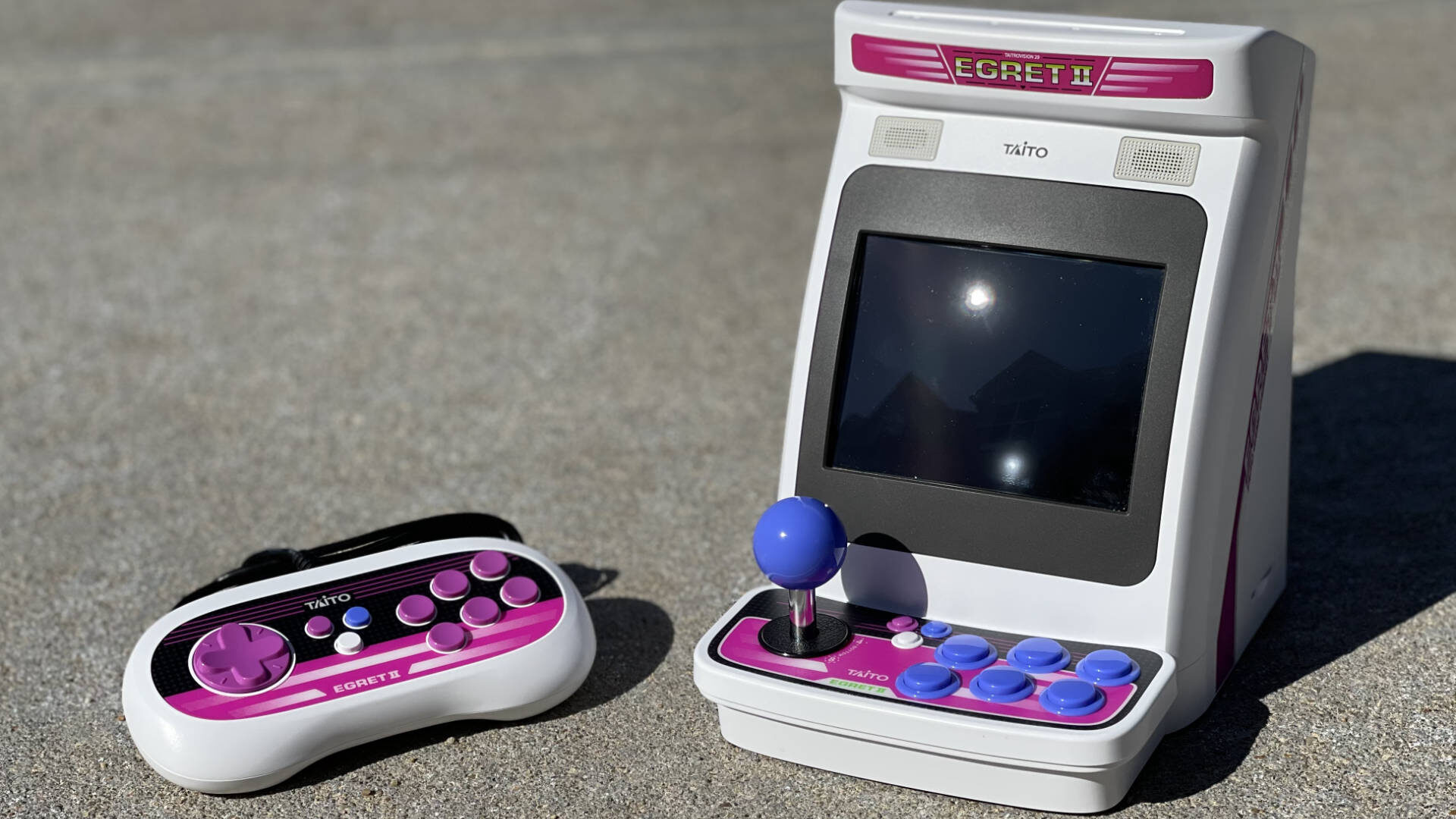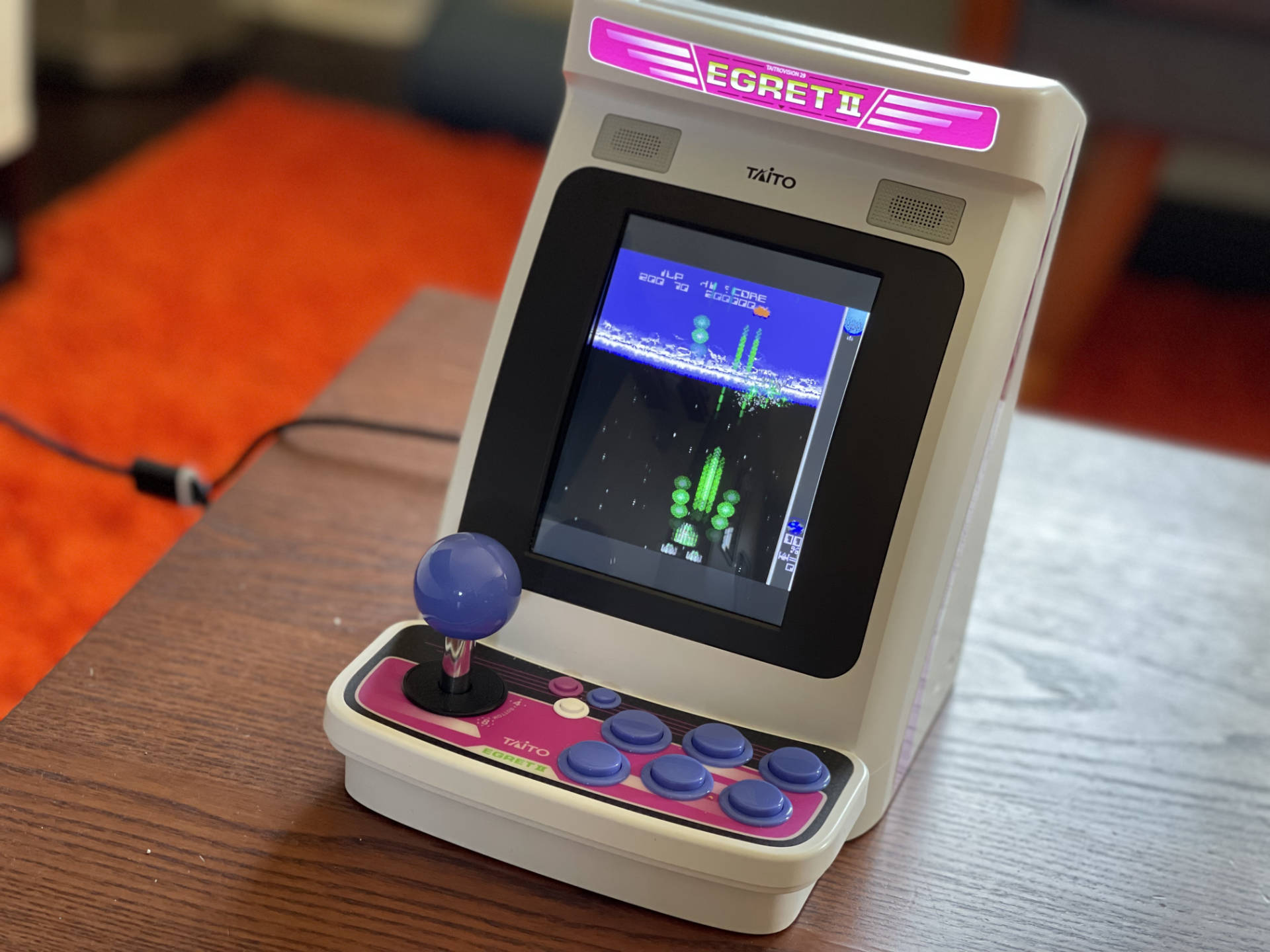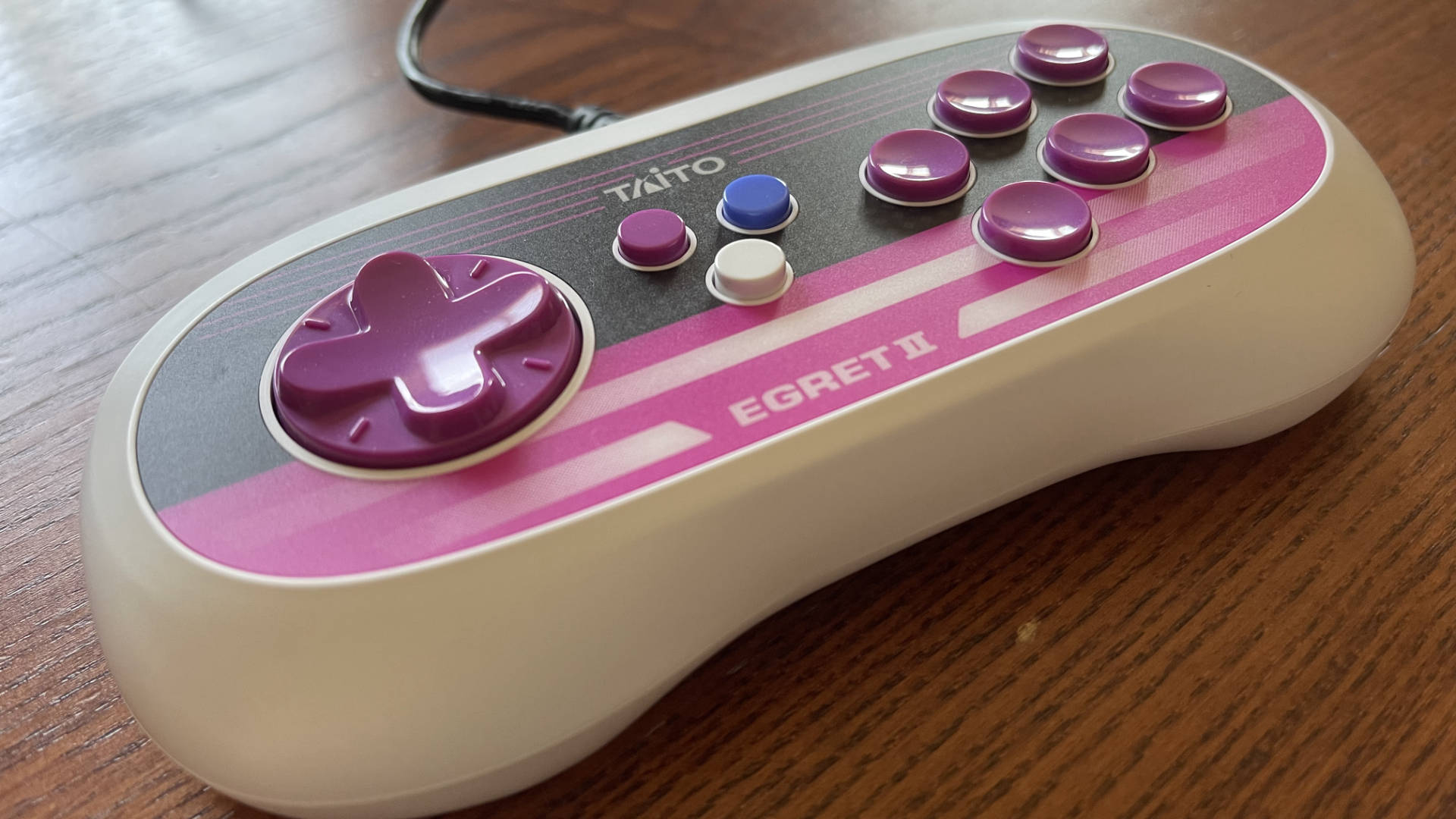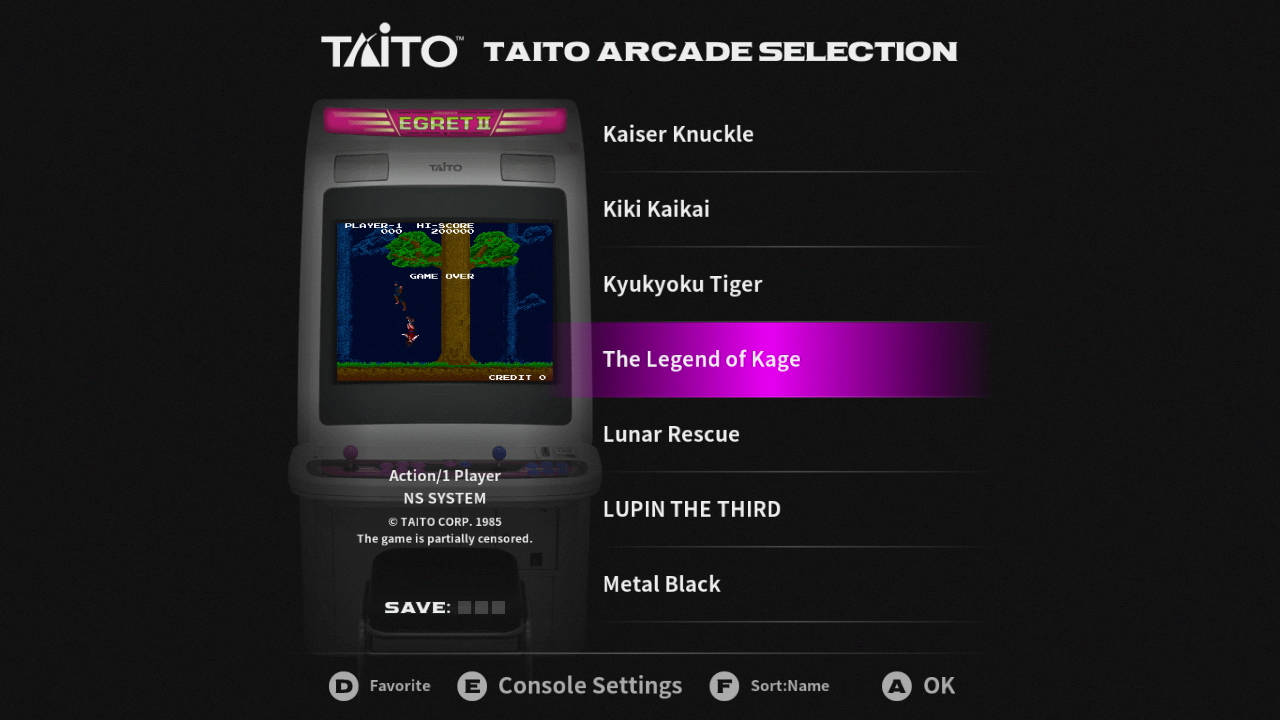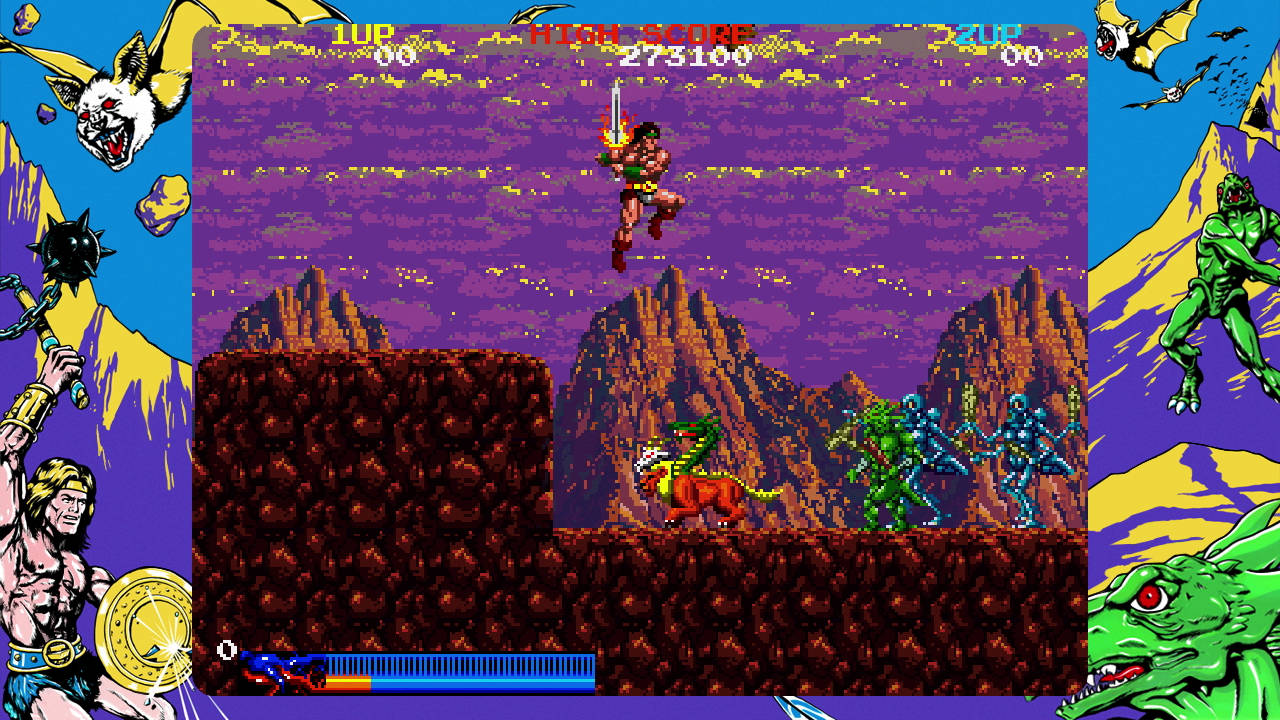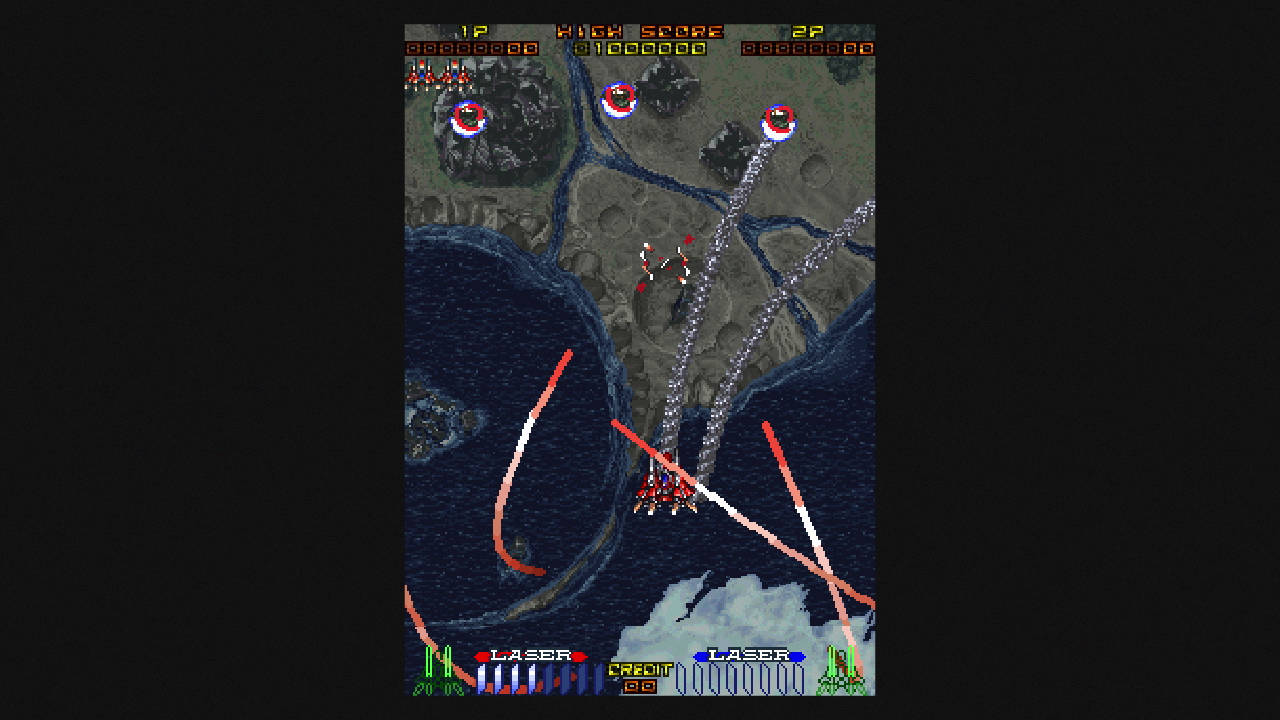Taito Egret II Mini – Limited Blue Edition Review
In November of 2016, I reviewed the NES Classic, a product Nintendo released seemingly to have something to sell for the holidays as the Wii U languished and the Switch was still preparing for launch. In the five-and-a-half years that have passed since, a new generation of all-in-one hardware has taken us on a crazy ride through retro gaming.
While products meant to emulate the experience of vintage consoles have waned in recent years, a new trend has emerged: replica arcade cabinets. 2018 saw two important milestones in this regard, as Arcade1Up began its business of selling 3/4-scale home arcade machines, and SNK released the NeoGeo Mini. As much of an SNK fan as I am, it’s almost hard to look back on the company’s efforts given how much better similar products have gotten as of late. One great example is Sega’s Astro City Mini, with another being the reason we’re here today: Taito’s Egret II Mini, specifically the Limited Blue Edition put together for customers outside Japan.
Hardware
If you’re a fan of Japanese arcade games—or simply arcades in general—then you’re probably familiar with “candy cabinets,” even if that term means nothing to you at first. Candy cabinets are a traditional style of arcade housing that rose to popularity in Japan, notable for their white bodies and sit-down design. One of Taito’s most well known brands of candy cabs is the Egret II, so it’s no surprise that the company used that design as the inspiration for their new foray into the all-in-one market.
I say the following without any hesitation: The Egret II Mini is easily the most impressive piece of miniaturized home hardware that I’ve had the chance to use since the higher-quality all-in-one trend began. It might be a tad unfair to compare the more “boring” console replicas to something that has a screen, speakers, and built-in controls, but it’s also hard not to be instantly impressed by this device the moment you take it out of the box.
It’s somewhat heartbreaking how much the Egret II Mini shames the NeoGeo Mini, and while I’ve not used it myself, Taito’s machine also seems to have a size advantage over Sega’s Astro City Mini, especially when it comes to the screen. The Egret II Mini features a 5” LCD display that looks great no matter what game you’re playing, built-in stereo speakers that won’t blow you away but which definitely get the job done, and a decently-sized joystick and set of buttons that, while slightly cramped, are perfectly usable for all of the included games. The joystick is microswitch-style and works great, and the buttons are nice and click-y. On the back, you get two USB-A ports for plugging in external controllers, a standard-sized HDMI port for playing on a television, a headphone jack, and a USB-C port for power—which, unexpectedly, we’ll need to come back to in this review. The unit also features an SD card slot for expanding the default game library, and a light-up instruction card stand and marquee, which are small but appreciated touches.
One of the most unique features of the Egret II Mini is also one of my favorite elements of the device: a rotating display. Being able to easily switch the monitor between yoko (horizontal) and tate (vertical) orientations was one of the trademarks of the actual Egret II, and seeing that feature preserved here is legitimately exciting as someone who often plays classic arcade titles on a rotatable monitor. Here on the Egret II Mini, gently pushing in on the bezels of the display causes the entire piece to pop forward, where you can then rotate it to suit the game you’re about to play. Thankfully, Taito has included a good mix of horizontally- and vertically-scrolling games on the system, so being able to adjust the screen goes from potential gimmick to legitimate feature I’ve used constantly.
Unfortunately, the other special detail on the Egret II Mini that I was looking forward to hasn’t worked out so well for me. Much like the screen itself, the restrictor gate on the joystick can rotate, so that instead of being moveable in the typical eight directions, you can lock it to only be usable in four. This is usually done to provide more precise control in games where quicker movements in only those four directions are important, such as something like Pac-Man. The problem is, there’s just something about how the stick on the Egret II Mini travels when locked into 4-way mode that I don’t like. Switching between the four cardinal directions isn’t smooth enough for my tastes, as I found myself having to fight too often to move between adjacent positions, such as from up to left, or right to down.
Finally, I should probably also give a quick mention to what makes the unit I received a “Limited Blue Edition.” In a partnership with United Games Entertainment, Taito has produced a variant of the Egret II Mini that has blue buttons and joystick toppers instead of the traditional pink versions. Only 5,000 of these units were created for the Western market, but the differences between what we’re getting and what Japan received really only comes down to that alternate hardware color—which causes a bit of a problem once we get to talking about the included games.
Accessories
While options like the rotating screen and joystick gate adjustment show the thought Taito put into the Egret II Mini, so too does the selection of accessories the company has made for the hardware. The most interesting to me is the Paddle and Trackball Game Expansion Set, which boasts a helfy controller deck featuring both a trackball and spinner paddle to help replicate the specialized controls of some of Taito’s arcade releases. The set comes with an SD card offering 10 additional games specifically tailored to those input devices, from the arcade classic brick-breaker Arkanoid to the company’s first golf game, Birdie King.
I’d love to tell you about the Paddle and Trackball controller, but alas I cannot, as the review unit I received did not come with one. What it did come with, however, was the Egret II Mini Control Pad—and boy did it leave me unimpressed. Additional controllers are going to be very important if you want to play multiplayer on the main unit itself, or play any of the games comfortably on a television, but the Control Pad is not the solution you’re going to want to go for. The overall shape of the controller feels weird in my hands, all of the face buttons are concave (whereas one row should be concave, and one convex), and worst of all, the D-pad is mushy mediocrity. The good news is that at least some other controllers do work with the Egret II Mini. I tried one of the 6-button pads from my Japanese Mega Drive Mini, and it was maginudes better than the official Taito offering. So, if you do go for this system and are needing external controllers, absolutely look into other options.
Presentation
The menus and main interface on the Egret II Mini exist between the “functional but lifeless” UI we got on the NeoGeo Mini, and the lavish homage to history we saw on the Turbografx-16 Mini. The main screen offers a simple list of the 40 included games, with a virtual Egret sitting to the left that shows preview video for whichever game is currently selected. Every title offers up to three save state slots, and you can tell how many saves you have for a particular game right from that main list. There’s absolutely nothing wrong with the interface we get here, but it’s also hard to get too excited about it either.
In terms of options, from the main menu you can adjust the unit’s screen brightness and speaker volume; stretch and/or rotate the image when playing on a television; change the menu background music, language, or demo (attract mode) settings; and turn off and on pixel filtering. Or, should I say, turn on and off. In a bizarre bug, turning filtering “on” actually turns it off, and vice versa. One nice touch is that, after selecting a game but before actually booting it, you can adjust some of its virtual DIP switches, such as number of lives, game difficulty, and other relevant settings.
While most of the experience in regards to presentation is pretty solid on the Egret II Mini, I do have a few complaints. While I’m not particularly a fan of them, I can find no scanline options of any kind—even when playing via HDMI out—which is a pretty big oversight. There also isn’t a way to adjust for overscan, which can be an issue if you want the play area increased to fill more of your screen’s size. Finally, when playing games that don’t fill the entirety of the screen, and when not using the built-in wallpapers to show visuals in those empty areas, the unused parts of the display are a dull gray instead of black. (Play any game that at some point shows a black screen, and you can instantly tell the difference.) It always drives me crazy when that’s the case, and there really should be the option to pick what color we want those unused portions of the screen to be.
Software
In a way, the Egret II Mini might be a bit of a tough sell for those of us in the West when it comes to its library. Taito’s back catalog doesn’t have the universal appeal of Nintendo or Sega, the hardcore fandom of SNK, the home computing nostalgia of the Amiga 500 Mini or C64 Mini, or the niche collectability of the Turbografx-16 Mini. Still, there’s a lot to like here, so let’s get to the list of games and then delve deeper into the topic.
|
|
If you’re strictly coming at that list in terms of what has name recognition in the West—especially today—then it’s easy to be disappointed with what’s offered. However, if you love delving into the history of the medium, or if, like me, you grew up in the heyday of arcades, then that’s an interesting and worthwhile list. Taito’s titles were incredibly important in the evolution of video games, and a lot of what’s included here remains enjoyable to this day if you take those games for what they are without modern-era expectations.
What I personally appreciate about the system’s library is the importance of some of its inclusions. Three games in particular—Elevator Action Returns, Metal Black, and RayForce (aka Layer Section, aka Galactic Attack)—especially speak to me because they were fantastic games that, for a long time, were infamous for being stuck on the Sega Saturn until the release of Taito Legends 2. (And with that compilation not hitting the PS2 and original Xbox until after their successors launched, it was easy to miss.) Outer Zone, meanwhile, never got a home port at all that I can remember, and Dan Ku Ga is an especially awesome addition, as it’s a previously unreleased sequel to Taito’s 1994 fighting game Kaiser Knuckle.
There’s two other interesting titles to note on that list: Kyukyoku Tiger, the Japanese version of my beloved Twin Cobra, and Tatsujin, aka the infamous top-down shooter we know on these shores as Truxton. While Taito published both, they were developed by Toaplan, which leads to a very interesting question. We already know that Taito is willing to add new games to the hardware via SD cards, so could the company not only potentially add more first-party games in the future, but perhaps titles from other developers as well? My mind races at the idea that the Egret II Mini could grow into a modern device that lets us reconnect with a wider swath of Japan’s arcade history, a task it’s perfectly set up for.
If I were to have one main complaint about the Egret II Mini’s library, it’s that there are some titles that I would love to have seen included that are missing—games such as Zoo Keeper, Front Line, The Ninja Warriors, Night Striker, and Cleopatra’s Fortune. Realistically, though, if Taito is planning to release any more game expansion packs in the future, they were obviously going to hold something back
…oh, wait, there is something else that I should probably mention: These are all the Japanese arcade versions of the games, even here on the unit specifically produced for us gaijin. For the most part, that doesn’t matter. The game you’ll remember as Growl now has the nonsensical name Runark, RayForce has a few tutorial pop-ups that you won’t be able to read (but you won’t really need to), and navigating Puzzle Bobble 2x’s menus might take a slight bit of trial and error. That is, until we get to Cadash. Cadash is a sort of side-scrolling arcade take on Dungeons & Dragons, and all of the important dialog boxes and mission instructions that pop up are all in Japanese. For some, this could make the game pretty much unplayable. It’s not as bad (or as cruel) as putting untranslated Snatcher on the Turbografx-16 Mini, but given an English-language arcade version of the game does exist, it’s kind of ridiculous that it wasn’t swapped in on a unit intended for English speakers.
Emulation
The easiest way to discuss the emulation quality of the Egret II Mini is to simply say this: If you’ve used any similar devices before, then you probably know what to expect.
For most, the games will run and play totally fine. Yes, there is input lag, but it’s not enough to ruin the experience of any of the games, even the shmups. There is occasionally some slight visual distortion due to trying to fit a wide variety of resolution on a LCD screen with a hard-set number of pixels, and you may experience things like shimmering when playing on a television due to a locked 720p output. You may also experience other occasional issues common with such emulation, such as audio hiccups or the random weirdness.
We’ve been through all this before by this point. Nintendo couldn’t get the emulation on either the NES or SNES Classics perfect, and Sega seeking help from M2, the masters of getting old games running again, still resulted in a Genesis Mini that didn’t fully nail the execution. The fact is, you’re never going to be able to perfectly run older games with software emulation and fixed-pixel displays, and least not with modern hardware at these price points. Unless you’re a stickler for emulation perfection, then you probably aren’t going to have any problem with how this hardware plays games, and even if you are, the issues it does have might still not be a dealbreaker. And so far, I’ve found no real dealbreakers with the Egret II Mini.
Well—that isn’t exactly true. See, there’s a very interesting hiccup with this hardware, and to discuss it, we need to go back to that USB-C power port. While the system comes with both an HDMI cable and USB-C to USB-A cable, it doesn’t include the power adapter itself, which may have been a mistake. Plenty of similar devices don’t come with them either, so typically people will just use one they have sitting around, or plug into their television’s USB port for power. The problem is, if the Egret II Mini isn’t getting enough power, not only can the input lag actually increase, but other issues with the system may also occur. Twitter user @takaflo posted an example video showing how the lag got worse in RayForce as the unit was getting less power. While it can easy to miss, the Egret II Mini’s packaging and instruction manual recommend a 5V/2.4A (12W) power adapter, but it should be safe to go higher. When I switched from a lower-powered adapter to an iPad one at that level, I did notice games seemingly playing better. So, if you do pick up an Egret II Mini, you’ll need to make sure you’re plugging it in with the proper adapter.
In Closing
The Egret II Mini – Limited Blue Edition is an undeniably cool piece of technology, and one of the most overall exciting all-in-one video game devices that we’ve received in recent years. Not only does it make for an awesome showpiece when sitting on a table or desk, but it’s also a great experience when playing as well. It’s just a shame that, in everything it does—from its hardware, to its games library, to its presentation—it doesn’t completely nail the execution. While none of its mistakes harm the system in any serious way, we do also have to keep in mind that just the main unit itself costs $229.99. I have no problem recommending the Egret II Mini to anyone who’s interested in it, but given both its price and its less casual-friendly library of games, I also have to recognize that that group of potential customers will probably be sizably smaller than for the other all-in-ones we’ve received.
Taito Egret II Mini
Summary: In the years since the NES Classic started the trend of higher-quality, official all-in-one retro gaming devices, Taito’s Egret II Mini is easily one of the coolest and most versatile pieces of hardware to see release. From its selection of classic and more modern Taito arcade hits, to its more accommodating size, to its adjustable joystick and screen, the system is as nice to use as it is to look at. A handful of smaller flaws keep it from reaching its full potential, while its price and library may also keep it from reaching its full consumer base.
Score: -
Taito Egret II Mini was reviewed using review code, physical copies, or hardware provided by United Games Entertainment. Scores are graded on a scale of E (Bad) to S (Special) in homage to Japanese video game grading scales, with the understanding that an S still does not denote a "perfect" score. Scores may have been adjusted from the original source to better fit my personal scale.
